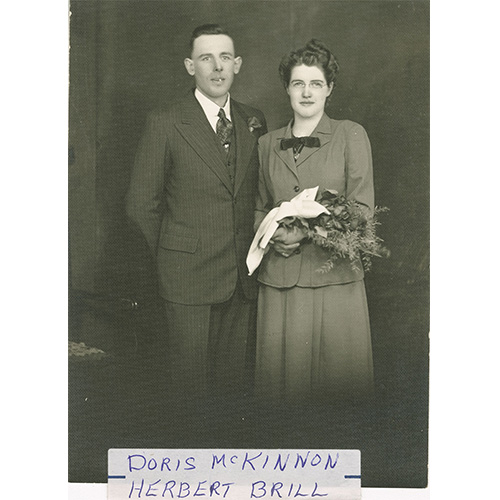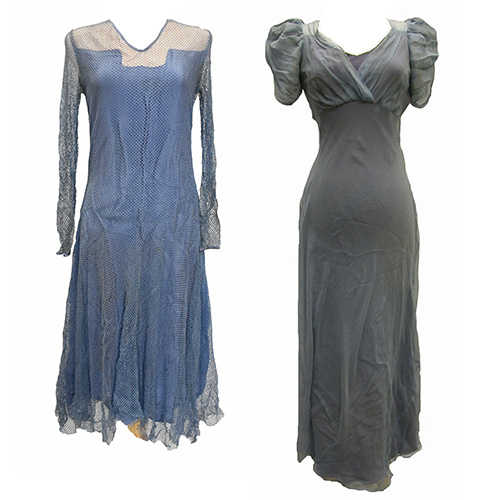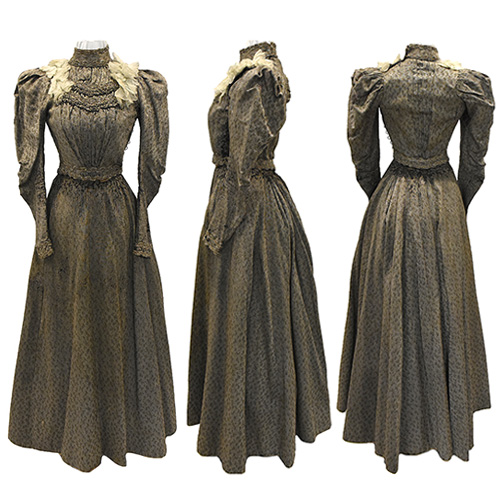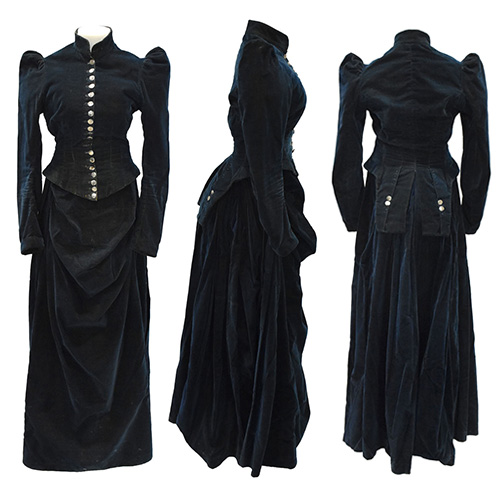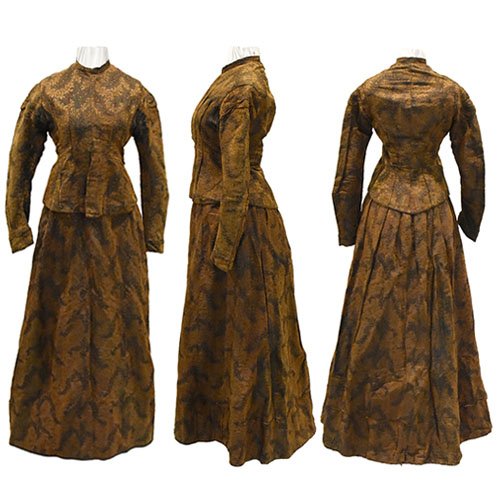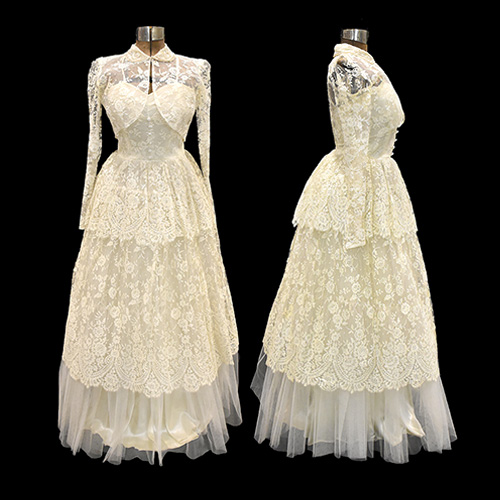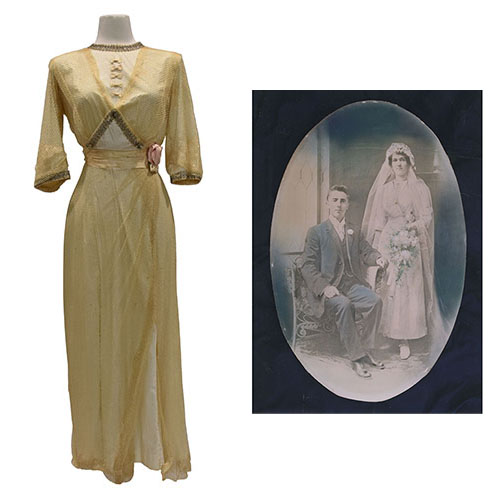Ivory, white and cream-coloured dresses weren’t always the default choice for Bruce County brides. In fact, white wedding dresses are a relatively modern Western convention. The BCM&CC collection contains several examples of wedding gowns in other shades and colours such as brown, black, grey, blue and purple.
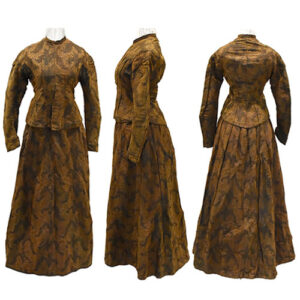
One of the museum’s oldest wedding dresses belonged to Nancy (Hemstreet) Cunningham. On October 13, 1874, she married Joseph Cunningham and wore this two-piece gown. It consists of a brown jacket and skirt featuring a gold and black brocade pattern. The back of the skirt is pleated to accommodate a bustle, which would have created the exaggerated silhouette fashionable during the Victorian era. The Cunninghams established the general store in Glammis a few years later, in 1878. [BCM&CC collection, 2019.023.003]
One Dress, Many Occasions
Bruce County brides like May (Switzer) Hodgins and Rhoda (Sherwood) Collins married function and form with these stylish yet sensible wedding ensembles:
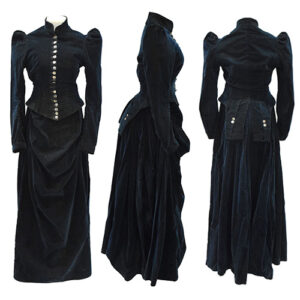
May Louise (Switzer) Hodgins walked down the aisle in navy-blue velvet when she married Joseph Hodgins in Culross Township on April 29th, 1891. This two-piece set (above) consists of a long, draped skirt and a fitted jacket with silver buttons up the front and split coattails at the back. [BCM&CC collection, 972.012.001]
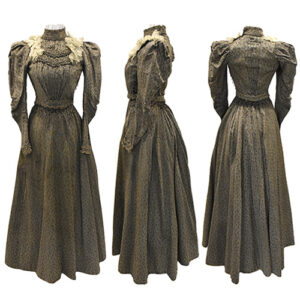
This grey and brown dress (above) belonged to Rhoda Anne (Sherwood) Collins, wife of Paisley butcher and town councilman, Johnathan Nathaniel Collins. It was likely worn for her wedding on Sept 28, 1898. [BCM&CC collection, 2023.014.005]
Yass Queen: a Vision in White(ish)
As pale dresses were impractical for most women, white garments would signify a certain degree of wealth and status for the wearer. While white was a common choice for affluent brides, many still chose other colours. When Queen Victoria wore an ornate gown of cream-coloured silk and lace to her wedding in 1840, however, the popularity of white wedding dresses increased drastically. As images of the Queen circulated over the following decades, more and more brides emulated her iconic look.
Victorian-era women’s magazines romanticized the trend, boosting the appeal of the white dress even more. In 1849, an American magazine called Godey’s Lady’s Book claimed:
“Custom has decided, from the earliest ages, that white is the most fitting hue [for brides], whatever may be the material. It is an emblem of the purity and innocence of girlhood […]”
Weddingwear of the Interwar Period
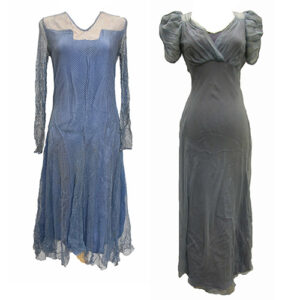
By the early 20th century, white dresses maintained their popularity, but it was not uncommon to see brides wearing other colours. Bodices, bustles, hemlines, and necklines continued to change with trends of the day. Through the interwar period of the 1920s and ‘30s, styles favored simplicity and understated elegance. Higher hemlines and streamlined silhouettes made their appearance at nuptial celebrations, exemplified here by the wedding dresses of Laura (Monk) Engle and Anna (Mcleod) Kreuger.
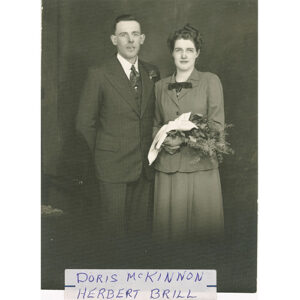
Above left: Laura Hannah (Monk) Engle of Elmwood, wore this blue tea-length, drop-waist dress for the photo after her wedding to John Henry Engel on May 1st, 1930. [BCM&CC collection, 2013.031.002]; Above right: This sleek, chiffon dress in muted purple was worn by Anna (Mcleod) Kreuger for her wedding to Ira Kreuger on February 20, 1939. [BCM&CC collection, 2014.018.001]
Practicality and resourcefulness made a comeback in the 1940s. During the War Effort, it was common for brides to wear something they already owned. Many brides, like Dorris McKinnon, walked down the aisle in a tasteful, tailored suit (right) .
Fashion Comes Full Circle
By the 1950s, the Second World War had ended and the economy was booming. The cinched waist and full skirt so fashionable in the mid-1800s was in vogue once again. The wedding dress below, worn by Marjorie (Thompson) Brown, could have jumped straight out of a 1950s bridal fashion magazine. Influenced by new fashion icons like Jackie Kennedy and Grace Kelly, the 1950s saw a resurgence of romantic bridal styles: white dresses with voluminous frills, delicate lace and beaded embellishments.
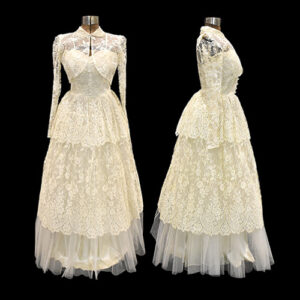
This lace and tulle wedding dress with spaghetti straps, sweetheart neckline and matching lace bolero was worn by Marjorie Eileen (Thompson) Brown when she married Gordon Brown on November 20, 1954. Marjorie was a founding member of the Jackson’s Women’s Institute and the Bruce County Heritage Association in Paisley, Ontario. She was also a regional district grand champion in quilting. [BCM&CC collection, 2022.026.001]
Though white, cream, ivory, champagne and blush have become the conventional colours of Western bridal fashion today, there are many wedding traditions in North America and around the world that involve an array of colours.
Sources:
Brennan, Summer. “A Natural History of the Wedding Dress”. JSOTR Daily, September 27, 2017. https://daily.jstor.org/a-natural-history-of-the-wedding-dress/
Chilton, Charlotte. “The Evolution of Bridal Style Through the Years”. Elle, March 16, 2020. https://www.elle.com/fashion/personal-style/g31437529/bridal-style-evolution/
Lee, Summer. “Queen Victoria’s Wedding Dress”. Fashion History Timeline. Updated February 6, 2020. https://fashionhistory.fitnyc.edu/1840-queen-victorias-wedding-dress/

